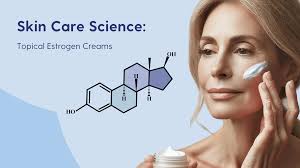
Topical Estrogen for the Face: Estriol Cream
I am seeing many ads on social media for topical estrogen and estradiol creams for the face to treat wrinkles and skin aging. The one being advertised the most is Alloy M4 Face Cream a face cream with estriol. Do these work? Are they safe, and which ones are best to use? I will discuss the various types of estrogen skin care, natural options and compare the pros and cons of each.
To shop for skin care using your Bauman Skin Type, take our skin care routine quiz.
Estrogen is a great anti-wrinkle cream
Only postmenopausal women with low breast cancer risk should use
Do not use if you have melasma or hyperpigmentation
There are prescription, cosmetic and natural forms of estrogen.
Discuss with your doctor before using
Why Use an Estrogen Face Cream?
There are really only 3 reasons to use an estrogen face cream:
Estrogen deficiency due to loss of ovarian function
Menopause
Transitioning to female gender.
Estrogen Deficiency
If you have had your ovaries removed or your estrogen levels are abnormal due to polycystic ovarian disease, or other disorders, discuss treatments with your doctor.
Menopause
Menopause heralds a new stage in a woman’s life, accompanied by many changes throughout the body, including the skin. My patients often complain of rapid skin aging, hair loss, acne, sun spots, dry skin, and itching during the premenopausal, menopausal, and postmenopausal years. As ovarian function wanes, declining hormonal levels significantly impact skin health and appearance. Understanding the science behind these cutaneous changes can help design the perfect skincare routine for maturing skin during the menopausal transition. The key is to protect the skin from aging with the best menopause skincare, and one promising option is the use of estrogen creams. Note that if you are already taking hormone replacement therapy (HRT) you probably do not need an additional estrogen cream. Please discuss with your doctor before using any of these topical estrogens.
Gender Transition to Female
Topical estrogen gets into the skin really easily and goes into the systemic circulation. So topical estrogen creams with greatly affect your hormone status. Please discuss with your gender affirmation care specialist before using any of these estrogen face creams. Hormone therapy is very complex and needs medical oversight.
Fine Lines and Wrinkles in Women
There are many good antiaging creams. The only way to know whichis best for you is to shop using your skin type octagon. When you take our skin type quiz, you will be assigned to 1 of 16 skin types. Once you know your skin type color and number, look for the skin type octagon when shopping for skin care to know if that is the best anti-aging product for you.
Estrogen Creams for Face
Estrogen creams are formulated to address the skin changes that occur with menopause. These creams contain different forms of estrogen, each with unique properties and benefits:
Estradiol : Known for its potency, estradiol is effective in improving skin elasticity and reducing wrinkles. Available with a doctor’s prescription only.
Estriol : A gentler alternative, estriol is less potent but still beneficial for skin hydration and reducing signs of aging. Available with a doctor’s prescription only.
Methyl Estradiolpropanoate (MEP) : A synthetic derivative that offers stability and effectiveness in skincare formulations. This is found in cosmetic skin creams that do not requre a subscription such as Emepellle.
Xenoestrogens : Synthetic or natural compounds that mimic estrogen in the body, sometimes included in skincare products for their estrogen-like effects.
Bioidenticals : Hormones identical in molecular structure to those the body produces, often used in hormone replacement therapies and increasingly in skincare for their natural effectiveness.
Plant-based Estrogens (Phytoestrogens) : Derived from plants, these estrogens are used in skincare for their gentle, estrogen-like effects, commonly found in ingredients like soy and wild yam.
Below are the estrogen or estrogen analog creams available without a prescription:
Benefits of Estrogen in Skincare
Estrogen creams offer several benefits for aging skin:
Preserves skin elasticity: Maintains elastin levels preventing sagging
Reduces fine lines and wrinkles: Stimulates fibroblasts to produce more collagen types I and III
Enhances skin hydration : Estrogen boosts the production of hyaluronic acid (HA), a natural moisturizer, and strengthens the skin barrier to help skin hold on to water.
Strengthens and thickens skin: With more collagen, HA, and elastin, the skin becomes thicker and more resilient.
Softens and smooths skin and reduces coarse facial hair
Side Effects of Estrogen Creams
While estrogen creams offer many benefits, they also come with potential side effects such as:
Hormonal imbalances
Increased risk of breast and uterine cancer
Melasma
Potential impacts on eczema and rosacea
On the other hand, the association between sex hormones and atopic dermatitis (AD) is less clear. Some studies report no consistent link between sex hormones and AD, while others suggest that fluctuating hormone levels during life stages like pregnancy and menopause can influence AD symptoms. The variability in findings suggests a complex relationship that warrants further research.
Estrogen’s Effects on Melasma
Estrogen will make your melasma worse. Do not use it if you have a any forms of hyperpigmentation.
Estrogen’s Effects on Rosacea
Research shows a significant connection between hormonal factors and the risk of rosacea. Studies indicate that rosacea is often diagnosed during perimenopause and can be influenced by hormonal changes during pregnancy or with the use of oral contraceptives. A study (3) involving 89,062 women found that postmenopausal women had a lower risk of rosacea compared to premenopausal women. However, the use of exogenous hormones, such as postmenopausal hormone therapy and oral contraceptives, was associated with an increased risk of rosacea. This means that estrogens creams used on the face may worsen rosacea. However, if rosacea is caused by hot flashes, the creams may improve rosacea.
Estrogen’s Effects on Eczema
The association between sex hormones and atopic dermatitis (AD) is less clear. Some studies report no consistent link between sex hormones and AD, while others suggest that fluctuating hormone levels during life stages like pregnancy and menopause can influence AD symptoms. The variability in findings suggests a complex relationship that warrants further research.
Safety
Estrogen creams should be used with caution, especially if you have:
A family history of breast cancer
BRCA gene mutation
Melasma or other estrogen-sensitive disorders
Conditions such as endometriosis or uterine fibroids
Pregnancy
Have a history of blood clots
Some tumors, particularly certain types of breast cancer, are known to be estrogen-responsive, meaning that estrogen can promote their growth. Therefore, individuals with a history of such tumors should avoid estrogen creams. Additionally, those with hormone-sensitive conditions should be particularly cautious. The use of estrogen creams can potentially exacerbate these conditions or lead to other health complications. Always consult with a healthcare provider before starting any new skincare regimen that includes estrogen creams, to ensure it is safe and appropriate for your individual health needs.
How Does Estrogen Affect the Skin?
Estrogen plays a significant role in skin health by:
Stimulating fibroblasts : This increases the production of collagen and hyaluronic acid, making the skin thicker, stronger, smoother, and less wrinkled.
Stimulates melanocytes to make pigment
Increasing moisture content : By boosting hyaluronic acid levels, estrogen helps keep the skin hydrated.
Protecting from oxidation : Estrogen has antioxidant properties that protect the skin from oxidative stress.
Loss of estrogen during menopause correlates with reduced collagen types I and IV in the dermis and basement membrane, leading to thinning of the skin, wrinkles, and reduced structural integrity.
Forms of Estrogen in Skincare
Estrogen can be delivered in various forms, each with unique benefits:
Pills : Systemic effects but potential for more side effects.
Patches : Provides a steady release of estrogen through the skin.
Serums and Creams : Direct application to the skin allowing increased estrogen levels in skin
Intravaginal applications : Targeted for vaginal health but can also benefit skin.
Skin Conditions Treated with Estrogen
Estrogen creams can help with various skin conditions, including:
Wrinkles
Dryness
Skin fragility
Sagging skin
Thin skin
Natural Alternatives to Estrogen
For those who prefer natural alternatives, phytoestrogens offer a plant-based option:
Phytoestrogens : Found in soy, flaxseed, and other plants, these compounds mimic estrogen and can improve skin hydration and elasticity.
Herbal extracts : Ingredients like saw palmetto and wild yams are commonly used for their estrogenic effects.
Foods High in Estrogen
Soy products
Flaxseeds
Sesame seeds
Garlic
Peaches
Berries
Estrogen creams can be a valuable addition to skincare routines for women experiencing menopause. By understanding the benefits and potential risks, you can make informed decisions about using estrogen in your skincare regimen. Take our skin care routine quiz to see if these products are right for you. Always consult with a healthcare provider to ensure the best approach for your individual needs.


